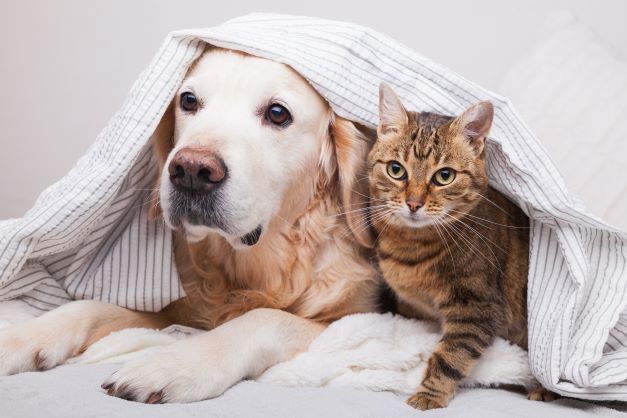Caring for pets in winter
While we warm up in winter with jumpers, jackets, heaters and extra bedding, we may over look our pets in this time. Like us, they too take time to adjust to the cooler months. Pets also benefit from some changes in their environment, diet and habits to cope when its colder. As their fur parents, it’s our responsibility to make sure they are warm and healthy throughout winter. You can do this by following some of the following tips.
Bedding
Ideally pets should be inside through winter, but for outdoor pets there are a few bedding changes that you can make to ensure they keep warm. Make sure they have a weatherproof shelter that’s off the ground and out of the wind, with extra bedding for colder days. If you have a pet who is older, feels the cold more or has a chronic health condition, electric heat pads and self-heating beds can be a good option.
Indoor pets also need special care. Their bed should be in a draft free location and elevated off cold, hard surfaces with extra bedding for warmth. If you have heaters running or fireplaces burning, make sure pet beds aren’t located too close, due to risk of fire. Caution needs to be taken with cats so that they aren’t at risk of jumping onto hot surfaces. Cats love to be up high so they feel secure and a warm, so an elevated bed will make them happy.
Winter Coat
Not all breeds grow a cold-weather coat in winter. Short haired pet breeds will benefit from the extra warmth and protection that a pet coat or jumper will provide outdoors. Generally speaking, older pets, small pets, pets with a thin or short coat or have low body fat will need this extra layer. Waterproof gear for rainy days will help you keep up with daily walks.
A good pet coat or jumper will give coverage from the neck to the base of the tail while also giving protection to their belly. Make sure it fits right and doesn’t restrict movement. Remember to remove your pet’s coat once they are in a heated indoor environment, so they don’t overheat.
Exercise
It’s important to keep up your regular exercise routine with your pet. It will not only boost both your moods it also acts as a boredom buster for pets. Keep playing indoors with soft toys or a ball to get the blood moving, or walk your pet during the day when it’s not as cold, as they will still love it. If the weather is really bad and you can’t get outside, add in some extra indoor play and stimulation.
Diet
It takes more energy to stay warm so your cat or dog may have an increased appetite. Dogs with low body fat, will need extra food to prevent weight loss as they will be burning energy just to stay warm. However, avoid overfeeding your pets throughout winter because winter weight gain is real for our pets too. If you are unsure on how much to feed them, talk to your vet to make sure your pet’s diet is right for their age, breed and lifestyle.
Pets still require plenty of fresh water in winter, especially when they are spending time indoors as the heating can dehydrate them quickly. If you live in a particularly cold area, be sure to check your pet’s water bowl regularly to make sure that it has not iced over.
Grooming
Keep up with normal grooming throughout winter to ensure skin and coat remain healthy and that nails are maintained. For dog breeds that grow an undercoat it is important to regularly brush them as matted fur will cause discomfort and lead to hours and hours of grooming at a later date. Baths should be less frequent than in the warmer months, and always in warm water.
It’s very important to continue with flea, tick and worm medication all year-round. Flea outbreaks are more common in winter. Keep up visits to the vet to ensure your pet maintains their health through winter.
Special care
Older pets, along with puppies and kittens all have special needs in winter. Puppies and kittens should be kept inside in extreme temperatures because they don’t have the fat, metabolism or fur coat to maintain their body temperature yet.
Older pets, or those with chronic illness, are also more at risk. Keeping them warm will help with any mobility issues, joint pain and stiffness, as will light and regular exercise.
If you notice your pet is showing signs of discomfort associated with arthritis or joint pain, you should take them to their vet for a check-up. Signs of pain or discomfort include stiffness, chewing or licking certain joints, difficulty walking up or down stairs, eating slowly and noticeable behavioural changes.
Pets are wonderful companions and loving members of the family. Snuggle up and stay warm together this winter, and remember, there’s nothing like lots of cuddles to keep the winter blues at bay!
Interested in similar articles? Why not check these out:
Extreme weather care for your pets
Source:
www.foodlandsa.com.au/magazine/
www.rspcaqld.org.au/blog/pet-care/tips-for-pets-owners-this-winter
www.greencrossvets.com.au/pet-library/articles-of-interest/winter-warming-tips/











